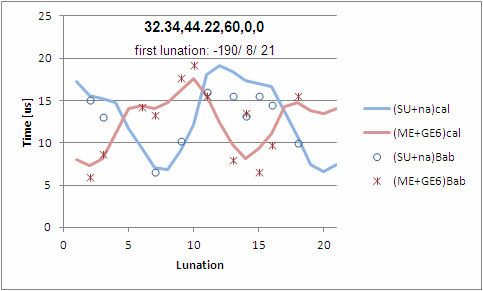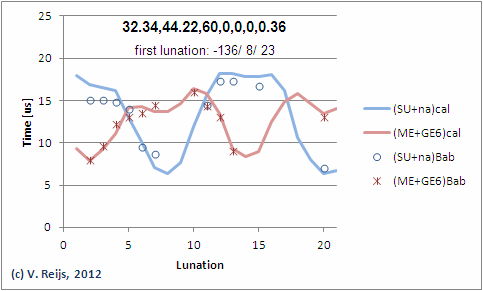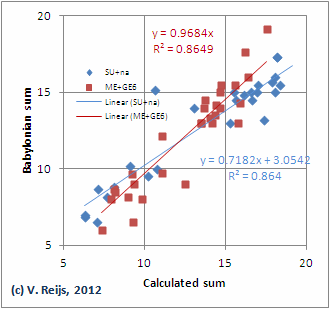NEW
In interesting aspect of the Lunar Four is that if one make sums like: ŠÚ+na; ME+GE6; and ŠÚ+na+ME+GE6, these sums become almost independent of longitude, latitude and horizon altitude. This is ideal for determining a parameters independent of location. Below picture is calculated using ARCHAEOCOSMO:

The spiky na curve (green) and smoother ŠÚ+na curve
(blue)
<Remark: above na curve is slightly different
then Brack-Bernsen's Figure 4 as that had a small ephemeris
error [Pers. Comm. Brack-Bernsen, 2012]>
Brack-Bernsen showed e.g. that ŠÚ+na+ME+GE6 is a
very good way to determine the periodicy of Lunation-length PΦ
[Lis Brack-Bernsen, and Matthias Brack. "Analysing shell structure
from Babylonian and modern times." In 10th Nuclear physics
workshop, 1-13. Kazimierz Dolny Poland, 2003, page 10.]: ~411.8
days (being the HarmonicDifference(Lunar
apse cycle, Tropical year)). (Meeus [2002], page 21-23)
From ŠÚ+na and ME+GE6 (above picture) one can
relate the Tropical year with 12.368 Synodic months.
| (naN)i=(naN)i-223
+ 1/3*(ŠÚ+na)i-229 |
mod(ŠÚ+na)i-229 |
| ŠÚi=ŠÚi-223
+ 1/3*(ŠÚ+na)i-223 nai=nai-223 - 1/3*(ŠÚ+na)i-223 |
mod(ŠÚ+na)i-223 |
| MEi=MEi-223 +
1/3*(ME+GE6)i-223 (GE6)i=(GE6)i-223 - 1/3*(ME+GE6)i-223 |
mod(ME+GE6)i-223 |
| KURi=KURi-223 + 1/3*(ME+GE6)i-229 | mod(ME+GE6)i-229 |
Green curve is nai while Blue curve is nai-223 - 1/3*(ŠÚ+na)i-223


